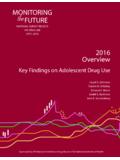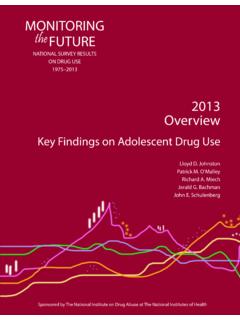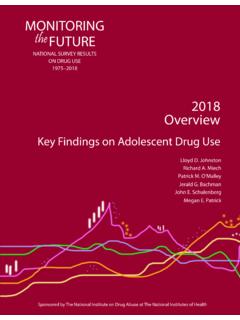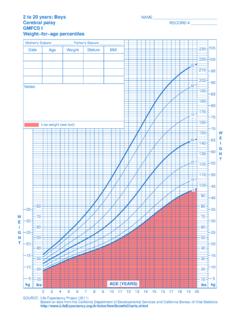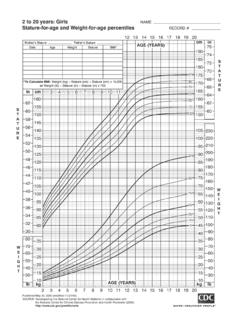Transcription of MINIMUM DRINKING AGE LAWS: EFFECTS ON AMERICAN …
1 MINIMUM DRINKING AGE laws : EFFECTS ON AMERICAN YOUTH 1976-1987 Monitoring the Future Occasional Paper 28 Patrick M. O Malley Alexander C. Wagenaar Institute for Social Research The University of Michigan Ann Arbor, Michigan 1990 i TABLE OF CONTENTS Page ii List of Tables .. iii List of Figures .. iv Abstract ..v Rationale and Background ..1 Representativeness and Analysis ..13 Descriptive Data ..14 Cross-Sectional MINIMUM DRINKING Age Differences: 1976-1981 ..16 MINIMUM DRINKING Age Differences: 1976-1987 ..18 Multivariate Controls ..19 MINIMUM DRINKING Age Differences: Post High EFFECTS of Changes in MINIMUM DRINKING Age laws .
2 22 Comparison of Use Before and After Change ..23 Adjusting for Secular Trends ..24 Differential EFFECTS on Subgroups ..25 effect on Variables Other Than Alcohol Use ..25 Analyses Linked to Official Discussion and Conclusions ..31 Tables ..37 Appendix A: Additional Tables ..A-1 Appendix B: Definitions of Measures .. A-2 Appendix C: FARS Analyses (by Alexander C. Wagenaar, Fredrick M. Streff, and Robert H. Schultz) ..C-1 ii ACKNOWLEDGMENTS This research was supported by a research grant from the National Institute on Alcohol Abuse and Alcoholism (AA05928). The self-report data were collected under a research grant from the National Institute on Drug Abuse (DA01411; Lloyd Johnston and Jerald Bachman, Principal Investigators).
3 Data analyses were completed while Dr. Wagenaar was at the University of Michigan s Transportation Research Institute. The authors thank Jerald Bachman and Lloyd Johnston for use of the data and their advice and assistance in this research; Fredrick Streff and Robert Schultz for their participation in the analyses of the traffic crash data and in the preparation of Appendix C; and Jerome Hiniker and Dan Zahs for assistance in data management and analyses of the self-report data. iii LIST OF TABLES Table Page 1. Cohort-Sequential Design of the Monitoring the Future 2. Response Rates in Follow-Up 3. MINIMUM DRINKING Ages by States, 1976-1987.
4 39 4. Numbers of Seniors by States, 5. Numbers of Schools by States, 1976-1987 ..42 6. Numbers of Seniors by MINIMUM DRINKING Age, 1976-1987 ..43 7. Numbers of States and Seniors with Consistent MINIMUM DRINKING Ages: 1976-1981 ..44 8. Regression Analyses: Background Variables Related to Alcohol Use, 1976-1981 ..45 9. MINIMUM DRINKING Age effect by 10. MINIMUM DRINKING Age effect on Alcohol-Related Fatal iv LIST OF FIGURES Figure Page 1. Alcohol Use (30-Day Mean) by MINIMUM DRINKING Age 1976-1981 ..49 2. Alcohol Use (Heavy DRINKING Mean) by MINIMUM DRINKING Age 1976-1981 ..50 3. Alcohol Use (30-Day Prevalence) by MINIMUM DRINKING Age 4. Alcohol Use (Heavy DRINKING Prevalence) by MINIMUM DRINKING Age 1976-1981.
5 52 5. Alcohol Use (30-Day Mean) by 2 Groups of States 6. Alcohol Use (Heavy DRINKING Mean) by 2 Groups of States 7. Alcohol Use (30-Day Prevalence) by 2 Groups of States 1976-1987 ..55 8. Alcohol Use (Heavy DRINKING Prevalence) by 2 Groups of States 1976-1987 ..56 9. Alcohol Use (30-Day Mean) by Year and Base-Year MINIMUM DRINKING Age, College Students, 1-4 Years After High School 10. Alcohol Use (30-Day Mean) by Year and Base-Year MINIMUM DRINKING Age, Non-College Students, 1-4 Years After High School 1980-1987 ..58 11. Alcohol Use (30-Day Mean) by Age and MINIMUM DRINKING Age ..59 12. Alcohol Use (Heavy DRINKING Mean) by Age and MINIMUM DRINKING Age ..60 13. Alcohol Use (30-Day Prevalence) by Age and MINIMUM DRINKING 14. Alcohol Use (Heavy DRINKING Prevalence) by Age and MINIMUM DRINKING Age ..62 15. Alcohol Use (30-Day Mean) Before and After Change.
6 63 16. Alcohol Use (Heavy DRINKING Mean) Before and After Change ..64 17. Alcohol Use (30-Day Prevalence) Before and After Change ..65 18. Alcohol Use (Heavy DRINKING Prevalence) Before and After Change ..66 19. Percent Change in Fatal Accidents by Type of Law Change ..67 20. Percent Change in Fatal Accidents and Self-Report Alcohol Use by Type of Law Change ..68 v ABSTRACT The research described in this report had two separate but related purposes: (1) to delineate cross-sectional differences among AMERICAN high school seniors and young adults that may be due to variations in recent years in state-level MINIMUM DRINKING age laws , and (2) to examine the EFFECTS of recent changes in MINIMUM DRINKING age laws on alcohol consumption, and on other relevant attitudes and behaviors.
7 The analyses utilize existing data collected by the Monitoring the Future project, an ongoing study involving (a) annual, nationally representative surveys of 15,000 to 19,000 high school seniors, and (b) annual follow-up surveys by mail of recent graduates. Thus, it was possible to assess the EFFECTS of different MINIMUM DRINKING ages on young people in the critically important age range from 17 to over 21. A separate, coordinated part of the research utilized official reports to examine EFFECTS on rates of fatal crashes following increases in the MINIMUM DRINKING age in several states. These official report data are compared with the findings from self-report data available from high school seniors. The major findings are: (1) higher MINIMUM DRINKING ages are associated with lower levels of alcohol use among high school seniors and recent high school graduates, even after multivariate controls; (2) lower levels of alcohol use are observed across a broad spectrum of demographic variables; (3) the lower levels of use persist into the early 20 s, even though everyone is of legal age; (4) lowered involvement in alcohol-related fatal crashes among drivers less than 21 years of age appears due to less DRINKING of alcohol in particular, less DRINKING in bars or taverns.
8 Occasional Paper 28 4 INTRODUCTION The research described in this report had two separate but related purposes: (1) to delineate cross-sectional differences among AMERICAN high school seniors and young adults that may be attributed to variations in state-level MINIMUM DRINKING age laws , and (2) to examine the EFFECTS of recent changes in MINIMUM DRINKING age laws on alcohol consumption, and on other related variables, including alcohol-related automobile crashes and other health-related The first purpose of the research is accomplished by examination of self-report data from annual surveys of high school seniors on their own alcohol-related behaviors, primarily consumption.
9 The research also provides information on the extent to which MINIMUM DRINKING age laws affect a broad array of other measures; more specifically, there are measures available on: (a) driving violations and traffic crashes following use of alcohol; (b) circumstances or setting of alcohol use; (c) reasons for DRINKING ; (d) degree and duration of intoxication; (e) attitudes toward DRINKING ; (f) use of other psychoactive substances; (g) delinquent behaviors and victimization experiences; (h) truancy; and (i) grade of first use of alcohol. The self-report data on crashes and violations provide information beyond that contained in official record systems; many minor crashes are not reported in official records, and information on the involvement of alcohol use is frequently not available for those events that are included in official records.
10 In addition to the annual surveys of seniors, sub-samples of each senior class are followed up after high school graduation. The dataset thus provides an opportunity to investigate the EFFECTS of different MINIMUM DRINKING age laws on large samples of young Americans as they make the important transitions from high school students to young adults, and as they move through a part of the life cycle during which they are at high risk for alcohol-related problems. The second purpose is to look at the effect of changes in MINIMUM DRINKING ages. Before-and-after data are available in a total of 26 states that raised their MINIMUM DRINKING ages between 1976 and 1987. In addition, EFFECTS of changes in MINIMUM DRINKING ages on official crash statistics in specific states are compared with EFFECTS on self-report data.
